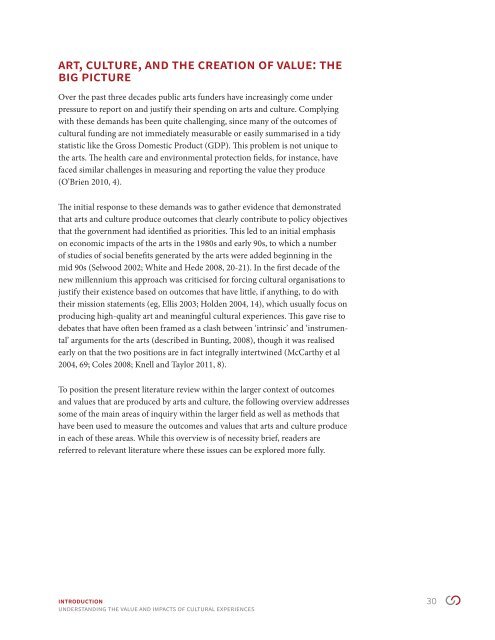aceUVi
aceUVi
aceUVi
You also want an ePaper? Increase the reach of your titles
YUMPU automatically turns print PDFs into web optimized ePapers that Google loves.
Art, culture, and the creation of value: the<br />
big picture<br />
Over the past three decades public arts funders have increasingly come under<br />
pressure to report on and justify their spending on arts and culture. Complying<br />
with these demands has been quite challenging, since many of the outcomes of<br />
cultural funding are not immediately measurable or easily summarised in a tidy<br />
statistic like the Gross Domestic Product (GDP). This problem is not unique to<br />
the arts. The health care and environmental protection fields, for instance, have<br />
faced similar challenges in measuring and reporting the value they produce<br />
(O’Brien 2010, 4).<br />
The initial response to these demands was to gather evidence that demonstrated<br />
that arts and culture produce outcomes that clearly contribute to policy objectives<br />
that the government had identified as priorities. This led to an initial emphasis<br />
on economic impacts of the arts in the 1980s and early 90s, to which a number<br />
of studies of social benefits generated by the arts were added beginning in the<br />
mid 90s (Selwood 2002; White and Hede 2008, 20-21). In the first decade of the<br />
new millennium this approach was criticised for forcing cultural organisations to<br />
justify their existence based on outcomes that have little, if anything, to do with<br />
their mission statements (eg, Ellis 2003; Holden 2004, 14), which usually focus on<br />
producing high-quality art and meaningful cultural experiences. This gave rise to<br />
debates that have often been framed as a clash between ‘intrinsic’ and ‘instrumental’<br />
arguments for the arts (described in Bunting, 2008), though it was realised<br />
early on that the two positions are in fact integrally intertwined (McCarthy et al<br />
2004, 69; Coles 2008; Knell and Taylor 2011, 8).<br />
To position the present literature review within the larger context of outcomes<br />
and values that are produced by arts and culture, the following overview addresses<br />
some of the main areas of inquiry within the larger field as well as methods that<br />
have been used to measure the outcomes and values that arts and culture produce<br />
in each of these areas. While this overview is of necessity brief, readers are<br />
referred to relevant literature where these issues can be explored more fully.<br />
Introduction 30<br />
UNDERSTANDING the value and impacts of cultural experiences


